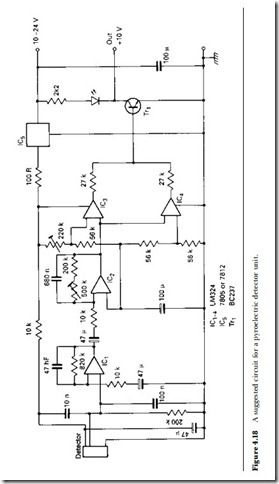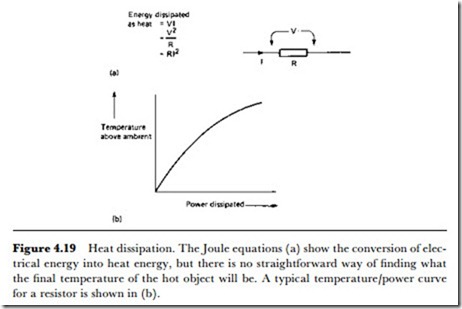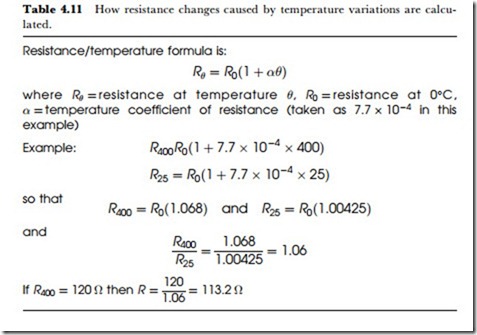Thermal transducers
The familiar transducer for electrical to thermal conversion is the heating element, and for most purposes this is composed of a nickel alloy wire such as Nichrome. This alloy of nickel, chromium and iron has good resistance to oxidation even when red hot, and its resistivity is high, so allowing a high resistance to be achieved without the need for very long lengths of narrow- gauge wire. The amount of energy transformed is given by Joule’s equation (Figure 4.19), but the level of temperature that will be caused by
a given current is less predictable. A material reaches a steady temperature when the rate of loss of heat energy is equal to the rate at which energy is input. The rate of loss depends on many factors other than the difference between the temperature of the material and the ambient temperature.
One point that is sometimes forgotten in making calculations on thermal conversion is that the resistance of a heating element is not constant. The current in a heating element is usually quoted as the operating current, the value of current for the hot element. Suppose, for example, that a heater has to operate at 240 V, 2 A. This implies that the resistance, when hot, will be 120 0. The resistance when cold will be less than this, and the differ- ence between these values depends on the temperature difference and the material. If the heater of our example uses nichrome and runs at 400oC then the resistance at room temperature (taken as 25oC) is 113 0, because the temperature coefficient of nichrome is small. If the heating element had been constructed of pure nickel then the resistance at room temperature would be about 47 0, a very considerable change. Table 4.11 shows the basis of these calculations. The changes in resistance are particularly marked for incandescent lamps, because of the large difference between cold temperature and working temperature. Some care should always be taken if you need to work with the resistance values of such lamps, since the cold value will be only a small fraction of the hot value.
Any conducting material will act as a transducer of electrical energy to thermal energy, so that the use of materials that have a negative value of temperature coefficient needs special care. Passing current through such a material from a fixed voltage supply can cause heating that in turn lowers
the resistance and increases the current. This ‘positive feedback’ can cause fusing or other breakdown unless some part of the circuit limits the amount of current that can flow. The most notable examples of this effect are semi- conductors and that curious mixture, glass.
The Peltier effect, discovered in 1822, is another form of electrical to heat transducer action, and is the reverse of the thermocouple (Seebeck) action. Once again, two junctions of dissimilar metals are used, and in this case, a current is passed around the circuit, resulting in one junction cooling and the other heating. The temperature changes for a given current are small for metal-to-metal junctions, but can be substantial for metal-to-semiconductor junctions, making this a useful way of temperature control for small spaces.


